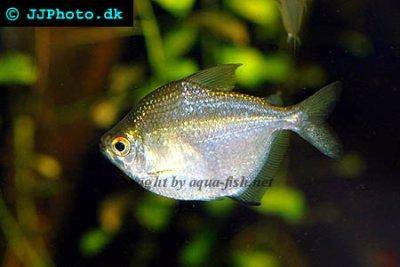Discus tetra - Brachychalcinus orbicularis
Scientific name: Brachychalcinus orbicularis
Common name: Discus tetra
Family: Characidae
Usual size in fish tanks: 8 - 9 cm (3.15 - 3.54 inch)
014
Recommended pH range: 5.5 - 7.5
Recommended water hardness: 6 - 20°N (107.14 - 357.14ppm)
0°C 32°F30°C 86°F
Recommended temperature range: 20 - 26 °C (68 - 78.8°F)
The way how these fish reproduce: Spawning
Where the species comes from: South America
Temperament to its own species: peaceful
Temperament toward other fish species: peaceful
Usual place in the tank: Middle levels
General Information
Discus tetra (Brachychalcinus orbicularis) is a deep-bodied characin from lowland rivers and creeks in northern South America. Adults reach about 8–9 cm and display a rounded, laterally compressed “discus” profile with a dark humeral spot and subtle banding. It is a peaceful schooling fish that shows best color and behavior in groups of 6–8 kept in a long tank with open swimming space and cover around the margins.
Food & Feeding
An omnivore/micro-predator in nature, feeding on small invertebrates and plant material. Offer a varied staple of quality flakes or small sinking granules, plus regular portions of frozen/live foods (daphnia, mosquito larvae, brine shrimp, finely chopped bloodworms). Include some vegetable content (spirulina-based foods, blanched spinach/peas) a few times per week. Feed modest portions 1–2× daily to maintain water quality.
Sexing
External sexual dimorphism is subtle. Mature females tend to be a little deeper-bodied/plumper, especially when gravid; males often remain slightly slimmer. Accurate sexing typically requires comparison within a group.
Breeding
B. orbicularis is an egg-scatterer. Use a separate, dimly lit breeding tank with fine-leaved plants or spawning mops to catch adhesive eggs. Condition a small group on rich live/frozen foods. After spawning, remove adults as no parental care is provided. Depending on temperature, eggs typically hatch in ~2–3 days, and fry become free-swimming a few days later. Start with infusoria/liquid fry food, then transition to newly hatched brine shrimp. Reported fecundity for mature females can reach roughly 1,000–2,000 eggs per spawn.
Lifespan
Commonly 5–6 years with good diet and consistent maintenance.
Tank Requirements & Water Parameters
- Tank size: a long footprint of 90–100 cm (36–40″) or larger for a group; prioritize open midwater lanes with cover around the sides/back.
- Water: pH ~5.5–7.5; hardness approximately 6–20 °dH; temperature 20–26 °C (68–79 °F). Note: some references list 18–24 °C as typical; slightly warmer water is often used for conditioning and breeding.
- Filtration & flow: clean, well-oxygenated water with regular, sizable water changes. Avoid chronic nitrate accumulation.
- Aquascape: open center for schooling; robust plants, roots and wood at the margins. May nip very soft/fine-leaved plants; choose sturdier species if you keep a planted layout.
Compatibility & Tank Mates
Peaceful community fish. Keep in a shoal and combine with similarly sized, non-nippy neighbors (medium tetras/rasboras, peaceful cichlids of appropriate size, Corydoras and other calm catfishes). Avoid very small fish that could be outcompeted at feeding time, and notorious fin-nippers.
Behaviour & Usual Place in the Tank
Active mid-water shoaler that appreciates open space for schooling and darker, structured edges to retreat when startled.
Short Description
Discus tetra is a rounded, schooling characin suited to spacious, clean community aquaria. Provide a varied omnivorous diet, stable soft-to-moderately hard water, and a group to see calm behavior and attractive schooling.
Q&A
- Where does it come from? Most sources place it in coastal drainages of Suriname and Guyana; some recent records extend into parts of the Amazon–Orinoco system.
- How many should I keep? At least 6–8; larger groups look better and reduce skittishness.
- Will it ruin my plants? It may nibble very soft plants; use sturdier species if you want a heavily planted aquascape.
- How hard is breeding? Moderate: egg-scatterer with no parental care; needs a separate tank, dim light, and very clean water. Fry require very small first foods.
Picture
Bought by aqua-fish.net from jjphoto.dk.


 Bloodfin
Bloodfin  Bloodfin
Bloodfin  Panda
Panda  Green
Green  Blind
Blind  Kennedy
Kennedy  Blue
Blue  Pink
Pink  Bucktoothed
Bucktoothed  Black
Black  False
False  Silver
Silver  Hemigrammus
Hemigrammus  Dash-dot
Dash-dot  Rummy
Rummy  Glowlight
Glowlight  January
January  Head
Head  Garnet
Garnet  Rummy
Rummy  Gold
Gold  Red
Red  Ember
Ember  Buenos
Buenos  Colombian
Colombian  Ecuador
Ecuador  Bleeding
Bleeding  Flame
Flame  Georgett’s
Georgett’s  Griems
Griems  Kitty
Kitty  Black
Black  Firefin
Firefin  Loreto
Loreto  Black
Black  Lemon
Lemon  Redback
Redback  Rosy
Rosy  Serpae
Serpae  Savanna
Savanna  Red
Red  Blue
Blue  Silver
Silver  Ceros
Ceros  Napo
Napo  Diamond
Diamond  Red
Red  Rainbow
Rainbow  Emperor
Emperor  Cardinal
Cardinal  Neon
Neon  Green
Green  False
False  Glass
Glass  X-ray
X-ray  Penguin
Penguin